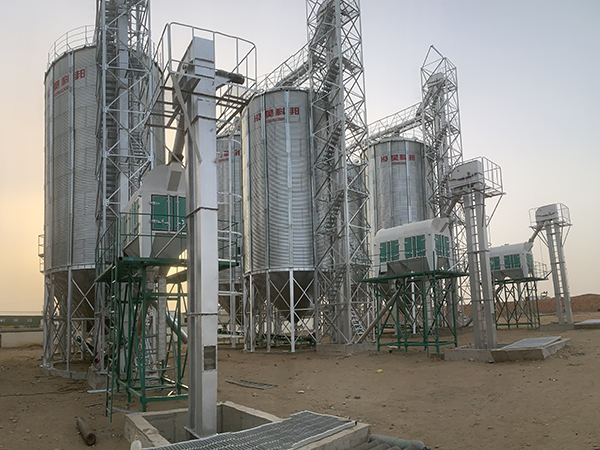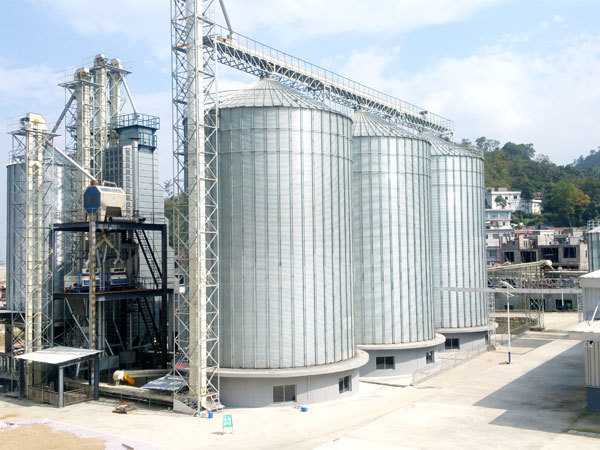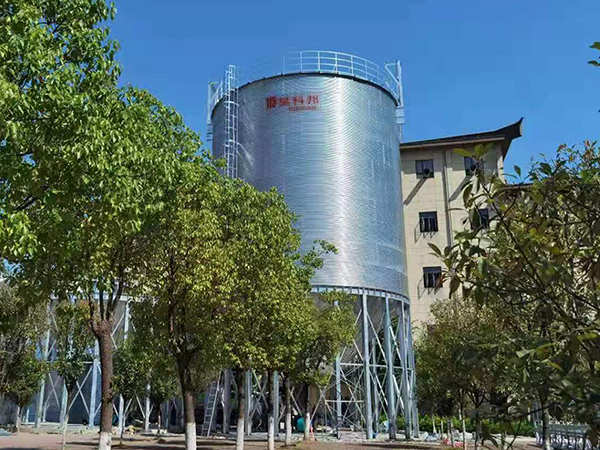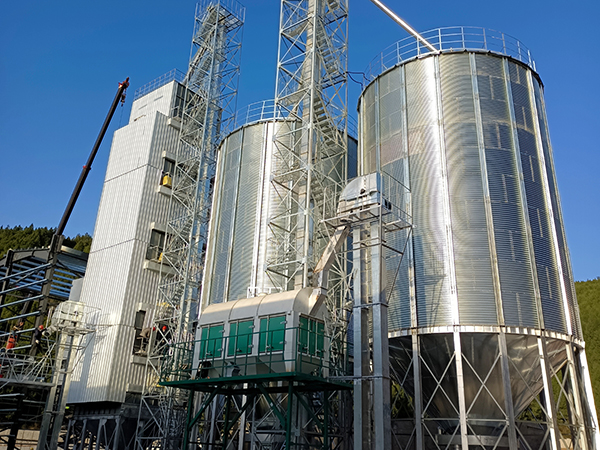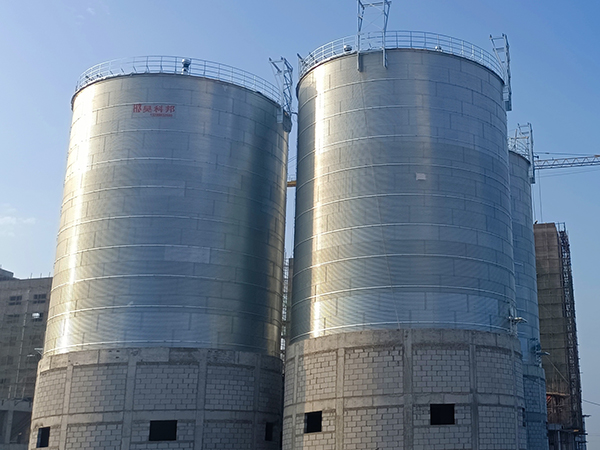Peanut grain bin
A peanut grain bin is an agricultural storage facility specifically designed for the storage of peanuts. It is typically engineered to protect peanuts from dampness
Peanut grain bin Introduction
A peanut grain bin is an agricultural storage facility specifically designed for the storage of peanuts. It is typically engineered to protect peanuts from dampness, pests, diseases, and other factors that may lead to a decline in peanut quality. The design and construction of a peanut grain bin need to take into account various factors, including capacity, ventilation, moisture resistance, rodent-proofing, and insect-proofing, to ensure the quality and safety of peanuts during storage.
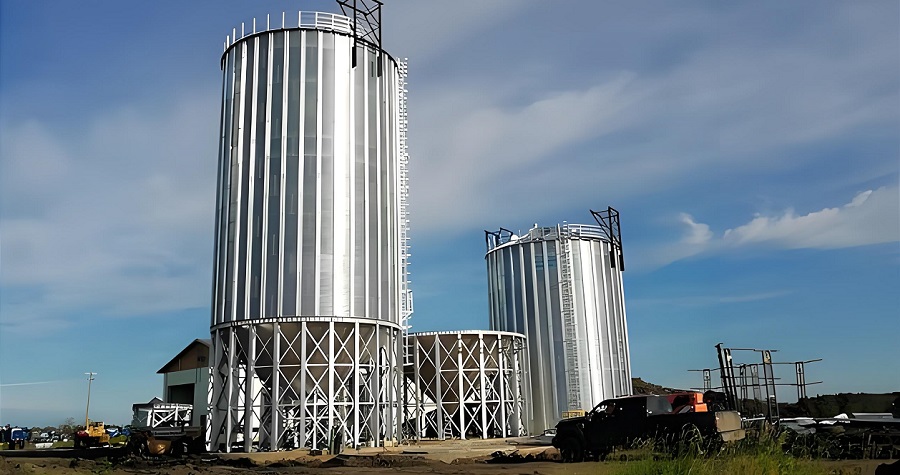
Features of peanut grain bin
Large-capacity storage
The peanut grain bin is designed with a spacious interior that can hold a substantial amount of peanuts, catering to the needs of large-scale agricultural production and enhancing storage efficiency and space utilization.
Good sealing properties
The structure of the grain bin is tightly sealed, with effective sealing measures applied to the roof, walls, and doors to prevent the entry of external moisture, pests, and impurities, ensuring that peanuts remain free from dampness, mold, and pest infestation during storage.
Ventilation system
The grain bin is equipped with advanced ventilation facilities, such as air vents, fans, and temperature and humidity monitoring devices, to regulate the internal temperature and humidity, preventing the peanuts from molding or overheating due to high humidity or unsuitable temperatures, and maintaining an optimal storage environment.
Moisture and mold protection
The bottom of the grain bin may use moisture-proof materials or have a moisture barrier to prevent moisture from the ground from affecting the quality of the peanuts. The walls and roof may be treated with moisture and mold-resistant coatings to strengthen the protective capabilities of the grain bin.
Pest control measures
The grain bin may be fitted with pest control nets, fumigation facilities, and other measures to fumigate the peanuts upon entry or employ biological or physical pest control methods to prevent pest infestations and protect the quality of the peanuts.
Intelligent monitoring
Modern peanut grain bins are typically equipped with intelligent monitoring systems, including temperature and humidity sensors, carbon dioxide detectors, and grain moisture meters, to monitor the internal environmental parameters of the grain bin in real-time, providing data support for scientific grain storage management.
Grain handling equipment
Efficient grain handling equipment, such as conveyors, elevators, and cleaning screens, ensures the quick and damage-free loading and unloading of peanuts, reducing manual operation and increasing work efficiency.
Fire safety
The grain bin is equipped with fire safety facilities, such as fire extinguishers, fire hydrants, and automatic fire suppression systems, to ensure the fire safety of the grain bin and guard against fire risks.
Structural stability
The main structure of the grain bin is sturdy and durable, capable of withstanding the weight of the peanuts and the impacts of natural environments (such as wind, snow, and earthquakes), ensuring long-term safety in use.
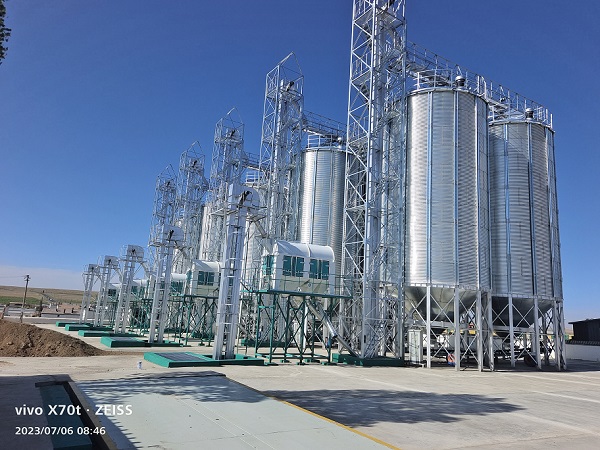
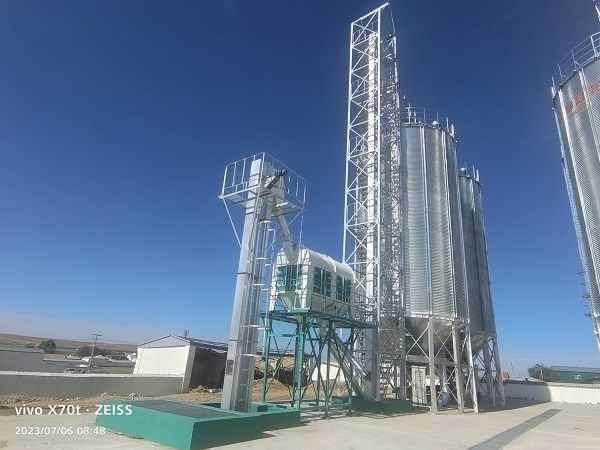
Structure of peanut grain bin
Storage Bin Structure
Walls: These form the protective enclosure of the bin, often constructed from materials like reinforced concrete, prestressed concrete, or steel structures, providing sufficient strength and rigidity to bear the weight of peanuts and external loads. The inner walls may be treated with moisture-proof and mold-proof coatings or lined with moisture-proof layers.
Roof: Covering the top of the bin, it serves to protect against rain, sun, and temperature changes. The roof material is chosen to facilitate drainage, ventilation, and natural lighting, and may feature skylights, vents, or other structures.
Floor: The base is designed to prevent moisture, pests, and facilitate the discharge of peanuts. In larger bins, the floor may be sloped or conical to allow for easy flow of peanuts.
In-Out Grain System
Inlet: Located at the top or side of the bin, equipped with grain deflectors, dust covers, and other facilities to ensure peanuts do not spill or become contaminated during storage.
Outlet: Positioned at the bottom or side of the bin, fitted with gates, chutes, conveyors, and other equipment for the rapid and orderly discharge of peanuts.
Cleaning Equipment: Including vibrating screens, magnets, air separators, etc., used to preliminarily clean peanuts before storage, removing impurities and foreign objects to ensure the quality of stored peanuts.
Ventilation System
Natural Ventilation: Airflow is naturally exchanged through skylights and vents on the roof, regulating the temperature and humidity inside the bin.
Mechanical Ventilation: Equipped with axial or centrifugal fans, air is forcibly exchanged through ductwork, precisely controlling the internal environment to prevent heating and molding of peanuts.
Measurement and Control System
Temperature and Humidity Monitoring: Sensors placed inside the bin monitor and record temperature and humidity changes, providing data for decisions on ventilation, fumigation, and other storage management actions.
Grain Condition Monitoring: The bin may be equipped with a grain condition monitoring system, using a wireless sensor network to monitor moisture, temperature, and other parameters of peanuts, enabling remote monitoring and early warning.
Fumigation System
Fumigation Chamber: Used for storing fumigants (such as phosphine tablets) and connected to the bin for fumigation operations.
Fumigation Piping: A network of fumigation pipes distributed throughout the bin, evenly dispersing fumigant gas to effectively kill pests.
Firefighting Facilities
Fire Extinguishing Equipment: Such as fire extinguishers and hydrants, placed in easily accessible locations inside and outside the bin.
Automatic Firefighting System: Large bins may have automatic firefighting devices, like smoke detectors and sprinkler systems, that respond quickly to the early stages of a fire.
Auxiliary Facilities
Ladders, Platforms: Facilitate inspection and maintenance of the roof, walls, and other parts of the bin.
Lighting, Electrical Equipment: Provide lighting for work inside the bin and power for ventilation, measurement, and control systems.
In summary, the structure of a peanut grain bin is composed of the storage bin, in-out grain system, ventilation system, measurement and control system, fumigation system, firefighting facilities, and auxiliary facilities. These components work together to achieve safe, efficient, and economical storage of peanuts.
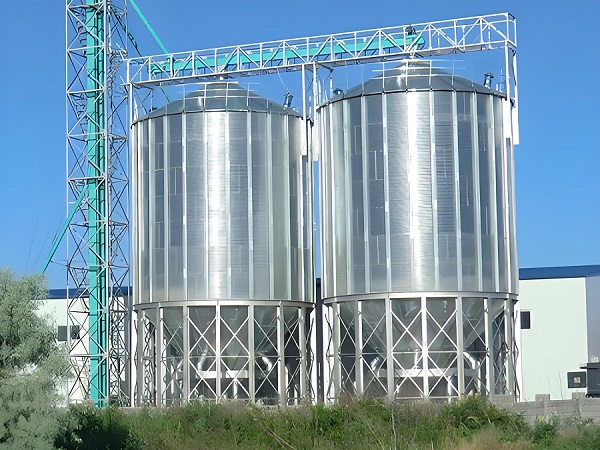
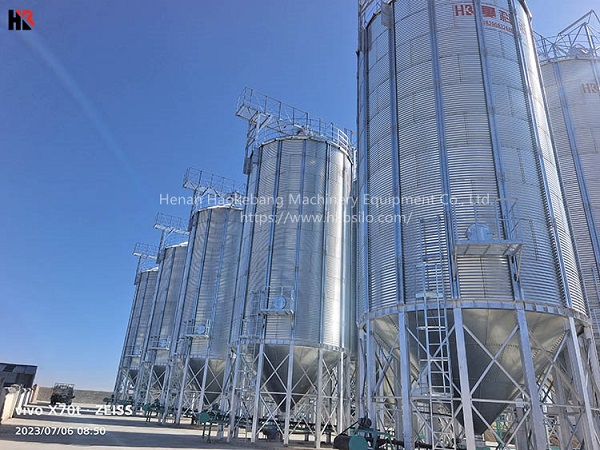
Advantages of peanut grain bin
Quality Protection
Through effective sealing and moisture-proof design, peanut grain bin can protect peanuts from dampness, mold, and pests, extending their storage life and maintaining quality.
Climate Control
Equipped with advanced ventilation and temperature-humidity control systems, peanut grain bin can regulate the internal environment, preventing spoilage due to unsuitable temperatures and humidity, ensuring the safe storage of peanuts.
Efficiency Enhancement
Reasonably designed and equipped with efficient grain handling equipment, peanut grain bin can improve loading and unloading efficiency, reduce manual labor, and lower costs.
Intelligent Management
Modern peanut grain bin may feature intelligent monitoring systems that enable real-time surveillance and data analysis of the storage status, enhancing management efficiency and decision-making.
Safety Assurance
The grain bin’s fire safety facilities and fumigation systems can effectively prevent and control pests and fire safety risks, ensuring the safety of peanut storage.
Strong Environmental Adaptability
The structural design of peanut grain bin considers the ability to withstand natural disasters such as wind, snow, and earthquakes, ensuring stability and safety under various environmental conditions.
Sustainable Development
Scientific and rational design and management of peanut grain bin help reduce food loss and waste, supporting sustainable agricultural development and food security.
Economic Benefits
Efficient storage management and reduced loss rates can enhance the market value of peanuts, bringing better economic benefits to farmers and enterprises.
Standard Compliance
The design and construction of peanut grain bin follow relevant national and industry standards, such as grain and oil storage technical specifications, ensuring the standardization and professionalism of the storage process.
Flexibility and Scalability
The design of peanut grain bin allows for expansion or modification as needed to adapt to different storage requirements and future market changes.
In summary, the advantages of peanut grain bins lie in their protection of peanut quality, efficient storage management, safety assurance, and economic benefits, which are all key factors in ensuring the stability and efficient operation of the peanut supply chain.
Application scope of peanut grain bin
Coban Silo is widely used for grain storage such as wheat, corn, soybean, paddy, rice, soybean meal, barley, malt, sunflower seeds, rapeseed, peanuts, flour, and other powder materials, oat, special Silo, and seeds, etc.
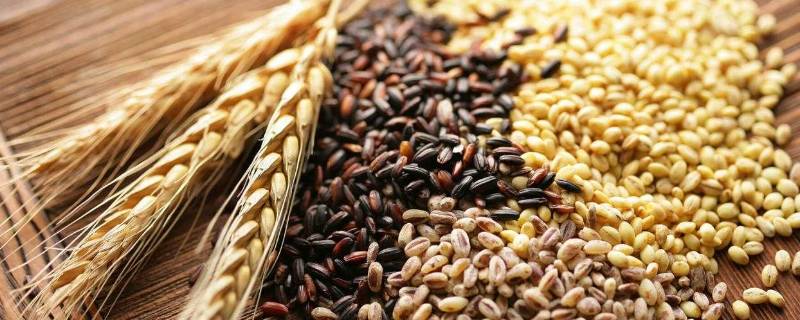
peanut grain bin technical parameters
Scientifically speaking, the Silo capacity should be measured with volume (m3). Even in the same grain Silo, the storage tons will be different for different grains with different densities. The following table is calculated based on a Silo density of 0.75kg/m3, and surely HKB customizes Silo systems unique for you.
| Most Popular Hopper Bottom Steel Silo Technical Specifications | ||||||||
| Capacity | 50Ton | 100Ton | 150Ton | 200Ton | 300Ton | 500Ton | 1000Ton | 1500Ton |
| Model | TCZK
03605 |
TCZK
04507 |
TCZK
05507 |
TCZK
06406 |
TCZK
07307 |
TCZK
07313 |
TCZK
11010 |
TCZK
12811 |
| Diameter(m) | 3.667 | 4.584 | 5.500 | 6.417 | 7.334 | 7.334 | 11.000 | 12.834 |
| Total Height(m) | 9.56 | 12.53 | 13.25 | 12.85 | 14.70 | 21.42 | 20.95 | 23.51 |
| Volume(m³)
Density:0.75ton/m³ |
69 | 150 | 222 | 273 | 415 | 699 | 1346 | 2039 |
| Most Popular Flat Bottom Steel Silo Technical Specifications | ||||||||
| Capacity | 1000Ton | 1500Ton | 2000Ton | 2500Ton | 3000Ton | 5000Ton | 8000Ton | 10000Ton |
| Model | TCK
10014 |
TCK
11915 |
TCK
13715 |
TCK
15514 |
TCK
15518 |
TCK
18321 |
TCK
24718 |
TCK
25621 |
| Diameter(m) | 10.084 | 11.918 | 13.750 | 15.584 | 15.584 | 18.334 | 24.751 | 25.668 |
| Total Height(m) | 18.69 | 20.34 | 20.87 | 20.30 | 24.78 | 28.60 | 26.99 | 30.60 |
| Volume(m³)
Density: 0.75ton/m³ |
1335 | 2009 | 2701 | 2467 | 4145 | 6693 | 10879 | 13484 |
After-sale Service
- – HKB provides advanced grain safety storage technology to assure your grain silo 100% quality stability.
- – grain silo Quality guarantee is one year after installation and commissioning or 18 months after leaving China Port. Maturity is the first.
- – 7 days x 24 hours service, within 24 hours reply/solve of any technical issues upon request.
- – Routinely telephone track to remove all might be problems grain silo or issues guarantying the whole system grain silo long-lasting safety and reliability.
- – HKB will consider all other needs like customs clearance, sea delivery, insurance, customs tax benefit plan, documentation, etc. So our respected Users feel so relaxed and easy to get the grain silo system well.

